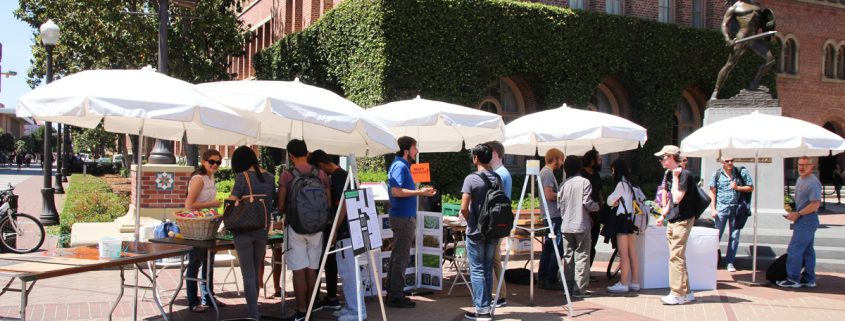Math festival helps educate students
The Mathematics Graduate Students Association at USC held their second annual Math Festival in Hahn Plaza on Wednesday, where different branches of mathematics were explained to students.
Can Oguz, a Ph.D. student in mathematics at USC, was the president of MGSA last year. He came up with the idea of the math festival and manned the algebra table.
“I really like the idea of having this math festival. I am a TA and I get more questions like, ‘What else is there in math?’” Oguz said. “The courses in math are limited and I think this festival was our only way to communicate what else is there beside the regular curriculum in mathematics.”
Six tables represented each area of mathematics that were highlighted: topology, geometry, combinatorics, algebra, probability and analysis. Students had the chance to win prizes depending on the number of stars they won for math games, like forming shapes out of pentominoes and dividing a shape into a number of other equal shapes on the combinatorics table. Each table had graduate students explain different math concepts.
Ezgi Kantarci, the president of MGSA and a graduate student in mathematics said that the highlight of the festival were the games.
“Organizing this festival was hectic, but it is also fun,” Kantarci said. “I get to play games with people all day, and plus we get a lot of positive reactions about math. So that is the best part.”
The topology table depicted the area of mathematics that studies different types of knots, links and braids. It was explained by the secretary of MGSA, Ilknur Egilmez.
“It is interesting to know that people actually study knot theory and it is something that is never shown in a class,” Egilmez said. “Mathematics is not only about integrals or something that you need to struggle with. So this festival will really change their [student’s] perspective towards math.”
On the geometry table, students dipped different symmetrical geometric shapes formed out of wire into soap water to see how the film formed by the wire took on different shapes. Professor Francis Bonahon of the mathematics department explained the phenomenon of minimal surfaces formed by these soap films around symmetric shapes.
Students had to solve analytical problems in order to earn a star at the analysis table. The probability table had a game of dice to teach students about probability.
The graduate students of the math department organized this festival with the help of the Academic Culture Assembly. Two graduate students of the computer science department, Eric Heiden and Bhaskar Bandyopadhyay reflected on the festival.
“I got to learn many new things about harmonographs, probabilities, complex algebra as well as combinatorics,” Bandyopadhyay said. “So it was very good.”
Heiden also recapped the positive aspects of the festival.
“It is a great event, and I think the math department got us some new things to see on campus, so it was really interesting,” Heiden said.

